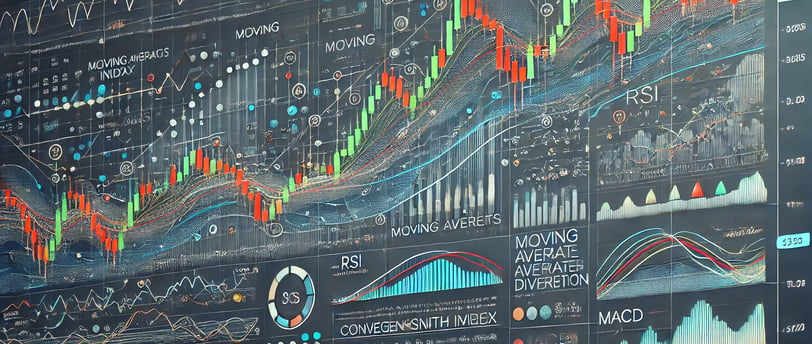The Comprehensive Guide to Technical Analysis: Mastering Market Dynamics
Welcome to Finance Inside, your premier resource for advanced financial insights and strategies. In this comprehensive guide, we delve deep into the world of technical analysis—a sophisticated approach employed by professional traders and investors to anticipate market movements based on historical price data and statistical trends.
9/26/20245 min read


Introduction to Technical Analysis
Technical analysis is a methodology for evaluating securities by analyzing statistical trends derived from market activity, such as price movements and trading volume. Unlike fundamental analysis, which focuses on a company's financial health and economic factors, technical analysis concentrates on market behavior as reflected in price charts and patterns.
The core premise of technical analysis is that historical price movements tend to repeat due to market psychology and behavioral patterns. By meticulously studying these movements, traders aim to forecast future price directions with a high degree of accuracy.
Foundational Principles of Technical Analysis
Market Efficiency: Technical analysts posit that all known information about a security is already factored into its price, making price analysis sufficient for informed decision-making.
Trend-Driven Price Movements: Prices tend to move in identifiable trends—bullish, bearish, or lateral—rather than randomly. Recognizing and capitalizing on these trends is crucial for successful trading.
Historical Pattern Recurrence: Market patterns, driven by collective human emotions and behaviors, are likely to repeat over time. Identifying these patterns can help predict future price movements with increased probability.
Essential Tools and Techniques in Technical Analysis
To effectively practice technical analysis, traders employ a diverse array of sophisticated tools, including advanced charting techniques, complex indicators, and pattern recognition algorithms. Let's explore the most critical components:
1. Advanced Price Charting Techniques
Price charts form the foundation of technical analysis, providing a visual representation of price movements over time. The most prevalent chart types include:
Line Charts: Ideal for identifying overarching trends, connecting closing prices over a specified period.
Bar Charts: Offering more granular information by displaying the open, high, low, and close prices (OHLC) for each time interval.
Candlestick Charts: Highly popular due to their visually intuitive format, providing the same information as bar charts but with enhanced pattern recognition capabilities.
2. Trend Analysis and Support/Resistance Identification
Trend Lines: Sophisticated tools for connecting significant price points, highlighting market direction. Upward trend lines connect rising lows (bullish), while downward trend lines connect falling highs (bearish).
Support and Resistance Levels: Critical price points where trends are expected to pause or reverse. Support levels indicate potential buying interest, while resistance levels signal potential selling pressure.
3. Advanced Technical Indicators
Technical indicators are complex mathematical calculations based on price, volume, or open interest, providing deeper insights into price trends and potential reversals.
Moving Averages (MA): Including Simple Moving Average (SMA) and Exponential Moving Average (EMA), these indicators smooth out price data to identify trend direction and potential reversal points.
Relative Strength Index (RSI): A momentum oscillator measuring the speed and change of price movements, helping identify overbought or oversold conditions with precision.
Moving Average Convergence Divergence (MACD): A trend-following momentum indicator showcasing the relationship between two moving averages, particularly useful for identifying bullish or bearish momentum shifts.
Bollinger Bands: Consisting of a middle band (SMA) and two outer bands representing standard deviations, helping traders assess market volatility and potential price reversals with statistical backing.
4. Sophisticated Chart Pattern Analysis
Chart patterns are complex formations created by price movements, classified into two main categories:
Continuation Patterns: Indicating the likelihood of trend continuation. Examples include flags, pennants, and rectangles.
Reversal Patterns: Suggesting potential trend reversals. Common examples include head and shoulders, double tops and bottoms, and wedges.
5. Volume Analysis Techniques
Volume analysis is crucial for confirming trends and identifying potential reversals:
On-Balance Volume (OBV): A momentum indicator relating price and volume, providing insights into the strength of a trend by measuring buying and selling pressure.
Volume Weighted Average Price (VWAP): A benchmark used by institutional investors to assess the quality of execution and identify liquidity opportunities.
Advanced Technical Analysis Methodologies
For traders seeking to elevate their analysis, these advanced techniques offer profound insights into market behavior:
1. Fibonacci Retracement and Extension
Based on the mathematical sequence discovered by Leonardo Fibonacci, these tools help identify potential reversal points and price targets:
Retracement Levels: Key levels include 23.6%, 38.2%, 50%, 61.8%, and 78.6%, often corresponding with areas of support or resistance.
Extension Levels: Used to project potential price targets beyond the original trend, typically at 127.2%, 161.8%, and 261.8%.
2. Elliott Wave Theory
A complex theory positing that market movements follow a series of five waves in the trend direction, followed by three corrective waves. Understanding these patterns helps traders predict future market movements and potential reversals with greater accuracy.
3. Ichimoku Cloud Analysis
A comprehensive indicator that defines support and resistance, identifies trend direction, gauges momentum, and provides trading signals. The "cloud" (Kumo) represents potential support or resistance areas and future price targets.
4. Harmonic Pattern Trading
Harmonic patterns are sophisticated chart formations that use Fibonacci numbers to identify potential reversal points with high precision. Examples include:
Gartley Pattern
Butterfly Pattern
Bat Pattern
Crab Pattern
These patterns require exact measurements and can predict future price movements with remarkable accuracy when properly identified.
Integrating Technical Analysis with Complementary Strategies
While technical analysis is powerful on its own, combining it with other analytical methods can significantly enhance your trading strategy:
Fundamental Analysis Integration: Use technical analysis to optimize entry and exit points based on fundamental analysis insights. For instance, if a company's earnings report is positive but the stock is technically overbought, wait for a pullback before entering a position.
Sentiment Analysis Correlation: Gauge market sentiment using indicators like the VIX (Volatility Index) or the put/call ratio, then correlate this with technical analysis to identify potential market turning points.
Quantitative Analysis Fusion: Integrate statistical models and algorithmic trading strategies with technical analysis to develop sophisticated, automated trading systems that capitalize on market inefficiencies.
Risk Management in Technical Analysis
Effective risk management is paramount to long-term trading success. Technical analysis aids in identifying optimal entry and exit points, but it's crucial to protect your capital with robust risk management techniques:
Advanced Stop-Loss Strategies: Implement trailing stops, volatility-based stops, and time-based stops to protect profits and limit losses dynamically.
Position Sizing Optimization: Determine the appropriate size of each trade based on your risk tolerance, the asset's volatility, and the overall market conditions using sophisticated risk models.
Portfolio Diversification Techniques: Employ correlation analysis and modern portfolio theory to diversify your holdings effectively, minimizing systemic risk while maximizing potential returns.
Conclusion: Achieving Mastery in Technical Analysis
Mastering technical analysis is an ongoing journey that requires dedication, continuous learning, and practical application. By developing proficiency in reading complex charts, identifying subtle patterns, and effectively utilizing advanced indicators, you can make more informed trading decisions and significantly increase your probability of success in the financial markets.
At Finance Inside, we are committed to providing you with cutting-edge tools and knowledge necessary to excel in the dynamic world of finance. This comprehensive guide serves as a foundation for developing a sophisticated technical analysis skillset.
Stay at the forefront of market insights by following our blog at Finance Inside. Remember, the key to success lies in continuous learning, unwavering discipline, and constant refinement of your trading approach. We wish you success in your trading endeavors.
The reference point for online finance and trading.
© 2024. All rights reserved.
Privacy Policy
Your privacy is important to us. Finance Inside is committed to protecting your personal information. When you subscribe to our newsletter or use our services, we collect personal information such as your name and email address to send you relevant content and updates about our services. This information will not be shared with third parties without your consent, except as required by law. We use advanced security measures to protect your data from unauthorized access.
Terms of Service.
Welcome to Finance Inside. By using our services, you agree to be bound by the following terms and conditions. The content and services provided by Finance Inside are intended for informational and educational purposes only and do not constitute financial advice or personalized investment recommendations. Finance Inside does not guarantee the accuracy, completeness, or reliability of the information provided. Users are responsible for their own financial decisions and any associated risks. Subscriptions to our services can be canceled at any time, with cancellations made at least 24 hours before renewal to avoid charges for the next period.
Disclaimer
The content provided by Finance Inside, including financial reports, eBooks, and other educational resources, is for informational and educational purposes only and does not constitute financial advice or personalized investment recommendations. Finance Inside does not guarantee the accuracy, completeness, or suitability of the information provided for any specific purpose.
The use of the information provided is at the sole discretion and risk of the user. Finance Inside will not be responsible for any losses or damages resulting from the use of the information provided in financial reports, eBooks, or other content.
Users are encouraged to consult a qualified financial advisor before making investment decisions.


Follow us on
